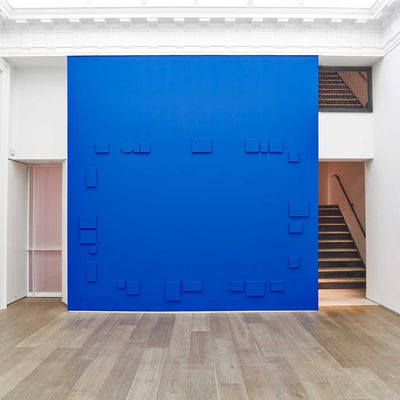
Ever since Perrotin Gallery moved to the Upper East Side last year it has become a landing pad of sorts for the Gallic set, ever more so since the Pop-oriented dealership (Emmanuel represents  Takashi Murakami, Kaws, and Pharrell in Paris, FYI) has focused most of its programming on French modernists overlooked by the American market. Recently, the 73rd Street space foisted Pierre Soulages and Germaine Richier onto the New York landscape, which was met with a bit of eye-rolling (since, after all, one often remains in obscurity for a reason).
This week, in fact, the cheeky Claude Rutault returns to town ÔÇö he was the first French artist to ever receive residency at PS1 MoMA in 1978ÔÇô79, and famously sparred with Alana Heiss (though, who doesnÔÇÖt?) with his indefatigably French poststructuralist philosopherÔÇÖs sense of humor. Fans of dry sarcasm will soon become fans of Rutault. ÔÇ£ItÔÇÖs very funny that not a single canvas of PicassoÔÇÖs Cubism was square,ÔÇØ he deadpans, then, after a sizable pause, he begins to chuckle. ItÔÇÖs no surprise to learn that Rutault, who doesnÔÇÖt speak a lick of English, is best friends with Lawrence Weiner and admits to being frenemies with Daniel Buren ÔÇö heÔÇÖs the only other French artist who roams on his own, explains Rutault. At 73, the ÔÇ£painterÔÇØ (there are quotes for a reason), whose whole practice is an inside joke between art history and his ÔÇ£charge-takersÔÇØ (a.k.a. collectors), does not actually paint his canvases nor does he oversee their execution in a factory-like studio, ├á la Koons or many of the other art stars of today. Instead, he writes texts, devised in a rubric he calls ÔÇ£de-finition/method,ÔÇØ and his paintings are made when the instructions have been completed. When I ask him if he thinks his works contains paradoxes, he replies, ÔÇ£What is a paradox?ÔÇØ He continues: ÔÇ£One could consider that the choices made are like a paradox. It can be seen as a paradox for the painter to not choose the color of his canvas, but I want the charge-taker to decide, since ultimately he has to live with it.ÔÇØ
When seeing the self-titled exhibition at Perrotin, expect a lot of white, raw canvases waiting to find their owner. One idea formed in 1978 when Rutault first lived on Park Avenue (he quickly decamped for East 3rd Street, next to the HellÔÇÖs AngelsÔÇÖ hangout, and eventually a windowless studio in Queens) that has crystallized in┬áIm/Mobilier ÔÇö a French pun of property/furniture ÔÇö a pair of canvases. The catch? While the left canvas will remain the same size, the right canvas will increase or decrease depending on the change in real-estate market prices. ÔÇ£ThatÔÇÖs clever,ÔÇØ I say to Rutault, who responds, ÔÇ£No, itÔÇÖs idiotic.ÔÇØ Originally, Perrotin wanted to pair his 1978 canvas with one from 2014 ÔÇö but the new painting would have been too big to hang on PerrotinÔÇÖs walls.
ItÔÇÖs curious that Rutault wants to return to New York at this very moment. When I ask him why, he says, ÔÇ£I was invited,ÔÇØ then he adds, ÔÇ£In truth, I am influenced by the American painting,ÔÇØ saying he wanted to see the Carl Andre show at DIA Beacon. Back in the day he ran around with Buren and made CBGBs his honorary living room (it was his favorite hang, he says) ÔÇö and though he leaves it to Perrotin to handle his market, his impression of the city is tied to the gallery scene. Many of the artists he ran with have ÔÇ£disappeared from history,ÔÇØ he adds, but never mind since they were mostly Pattern Painters, ÔÇ£une mode que je deteste.ÔÇØ Not only did he famously ditch an appointment with Ileana Sonnabend, but he remembers when Holly Solomon, the spunky dealer who famously championed Laurie Anderson, Robert Mapplethorpe, and Gordon Matta-Clark very early on, snubbed him. ÔÇ£Affixed to my door was a poster for an exhibition inside my studio, and Holly Solomon came by, peeked in, and said, ÔÇÿThereÔÇÖs nothing to see; letÔÇÖs move along.ÔÇÖ I was proud of that,ÔÇØ Rutault recalls. Is he joking? One can never be sure.


